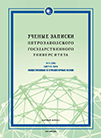МОТИВ КАК СРЕДСТВО ПРЕДСТАВЛЕНИЯ КОНТЕКСТУАЛЬНОГО
СОДЕРЖАНИЯ В СВЯТОЧНЫХ РАССКАЗАХ Н. С. ЛЕСКОВА
MOTIVE AS A TOOL OF CONTEXTUAL REPRESENTATION
OF SHORT CHRISTMAS STORIES BY N. S. LESKOV
Author(s): Natalia Nikolaevna StaryginaSubject(s): Language and Literature Studies
Published by: Петрозаводский государственный университет
Keywords: contextual poetics; contextual contents; Christmas and Yule contexts; forms and means of contextual representation; Leskov; Yule short stories
Summary/Abstract: The aim of the article is to demonstrate effectiveness of the motive as a tool of contextual representation (or a motive complex)in literary works. Short Christmas stories by N. S. Leskov are the subject of the study. The content and poetics of these stories aredetermined by Christmas and Yule contexts. Analysis of the motive as of the tool of contextual poetics is based on the perceptionof contextual poetics. Contextual poetics is understood as a system of forms of contextual representation, which was formed by thevariety of means and methods revealing the sense and the meaning of the text. The forms of contextual representation include the following: the intertextual sphere of the literary work, the concept sphere, the local text, the author’s individual text and etc. Alltogether they determine a contextual paradigm of the writer’s works. These forms are created with the help of different poeticalmeans (a motive, a symbol, an image, an inter texteme, etc.) and methods (naming, quotation, allusion, etc.). The Christmas and Yule motivational complex in such short stories as “The Pearl Necklace”, “The Unconvertable Ruble”, “The Beast”, “The Castle Ghost”includes multiple Christian motives (mercy, good will, growth of a human soul, change, challenges, inner conflicts and their overcoming),pagan motives (turn skinning, deviltry, commemoration meetings, etc.), contextual-situational motives (celebrations, presents’sharing, masking, fortune-telling, games, etc.). First of all, these motives form both a contextual sphere and a concept sphere,which act as basic forms for representation of Christmas and Yule contents in the Yule works of the writer. Contextual-situationaland pagan motives, which represent Christmas and Yule contexts, transform because of the concrete living position depicted in thewriter’s literary works. Christian motives remain unchanged with their original meanings and basic concepts of love, spirit, faith,conscience, salvation, etc. The given approach to the analysis of contextual poetics is based on modern theoretical concepts used bythe literature-studying practice. The approach is systemic and complex by nature, which allows consideration of such phenomenonas contextual poetics.
Journal: Ученые записки Петрозаводского государственного университета. Общественные и гуманитарные науки
- Issue Year: 2016
- Issue No: 5 (158)
- Page Range: 98-104
- Page Count: 7
- Language: Russian

